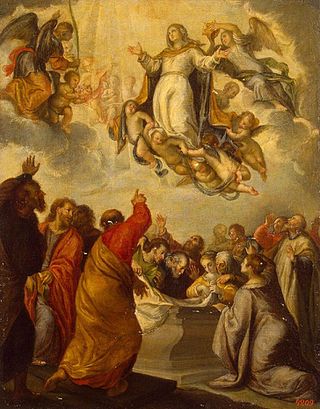
Pointillism is a technique of painting in which small, distinct dots of color are applied in patterns to form an image.

Paul Victor Jules Signac was a French Neo-Impressionist painter who, with Georges Seurat, helped develop the artistic technique Pointillism.

Bartolomé Esteban Murillo was a Spanish Baroque painter. Although he is best known for his religious works, Murillo also produced a considerable number of paintings of contemporary women and children. These lively realistic portraits of flower girls, street urchins, and beggars constitute an extensive and appealing record of the everyday life of his times. He also painted two self-portraits, one in the Frick Collection portraying him in his 30s, and one in London's National Gallery portraying him about 20 years later. In 2017–18, the two museums held an exhibition of them.

The Prado Museum, officially known as Museo Nacional del Prado, is the main Spanish national art museum, located in central Madrid. It is widely considered to house one of the world's finest collections of European art, dating from the 12th century to the early 20th century, based on the former Spanish royal collection, and the single best collection of Spanish art. Founded as a museum of paintings and sculpture in 1819, it also contains important collections of other types of works. The Prado Museum is one of the most visited sites in the world and is considered one of the greatest art museums in the world. The numerous works by Francisco Goya, the single most extensively represented artist, as well as by Hieronymus Bosch, El Greco, Peter Paul Rubens, Titian, and Diego Velázquez, are some of the highlights of the collection. Velázquez and his keen eye and sensibility were also responsible for bringing much of the museum's fine collection of Italian masters to Spain, now one of the largest outside Italy.

Henri-Edmond Cross, born Henri-Edmond-Joseph Delacroix, was a French painter and printmaker. He is most acclaimed as a master of Neo-Impressionism and he played an important role in shaping the second phase of that movement. He was a significant influence on Henri Matisse and many other artists. His work was instrumental in the development of Fauvism.

Juan de Pareja was a Spanish painter born in Antequera, near Málaga, Spain. He is known primarily as a member of the household and workshop of painter Diego Velázquez, who enslaved him until 1650. His 1661 work The Calling of Saint Matthew is on display at the Museo del Prado in Madrid, Spain.

Achille-Émile Othon Friesz, who later called himself Othon Friesz, a native of Le Havre, was a French artist of the Fauvist movement.

Divisionism, also called chromoluminarism, is the characteristic style in Neo-Impressionist painting defined by the separation of colors into individual dots or patches that interact optically.

Cullera is a city and municipality of Spain located in the Valencian Community. It is part of the province of Valencia and the Ribera Baixa comarca. The city is situated near the discharge of the river Júcar in the Mediterranean Sea.

Friar Juan Bautista Maíno, or Mayno was a Spanish Baroque painter.

Francisco Camilo was a Spanish painter, the son of an Italian immigrant who had settled in Madrid. When his father died, his mother remarried, and Camilo became the stepson of the painter Pedro de las Cuevas.

The Gibran Museum, formerly the Monastery of Mar Sarkis, is a biographical museum in Bsharri, Lebanon, 120 kilometres (75 mi) from Beirut. It is dedicated to the Lebanese writer, philosopher, and artist Kahlil Gibran.

The Musée Cantini is a museum in Marseilles that has been open to the public since 1936. The museum specializes in modern art, especially paintings from the first half of the twentieth century.

Baigneuses: Deux nus dans un paysage exotique is an oil painting created circa 1905 by the French artist and theorist Jean Metzinger (1883–1956). Two Nudes in an Exotic Landscape is a Proto-Cubist work executed in a highly personal Divisionist style during the height of the Fauve period. The painting is now in the Carmen Thyssen-Bornemisza Collection, Spain.

Saint Peter and Saint Paul is a 1587-1592 painting by El Greco, one of several versions of the theme by the artist - others are now in Barcelona and Stockholm. It shows the apostles saint Peter and saint Paul. The work was once shown on a stamp produced by the USSR.

The Virgin Mary as a Child Praying is a 1658–1660 painting by Francisco de Zurbarán, now in the Hermitage Museum in St Petersburg. Its theme is similar to that of his The Young Virgin. The painter completed the work in Madrid a few years before his death.

Isaac Blessing Jacob is a 1665-1670 oil on canvas painting by Bartolomé Esteban Murillo, forming a pair with Jacob's Dream. Both paintings were acquired via Dominique Vivant Denon in Paris in 1811 for the Hermitage Museum, in Saint Petersburg, where they still hang, along with 26 other works by the artist and his studio.

















